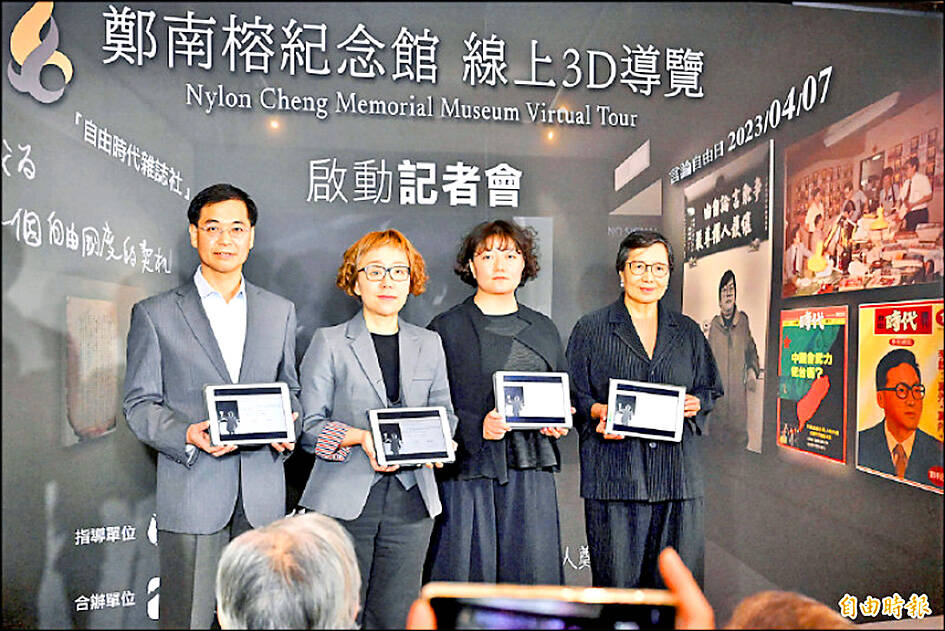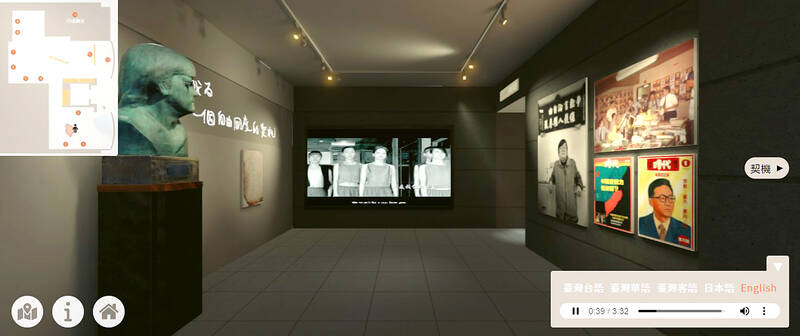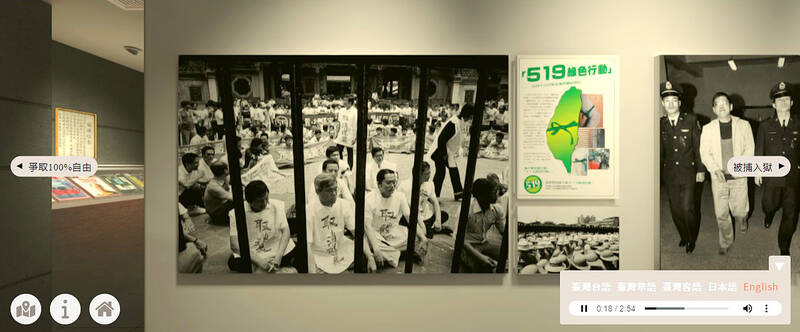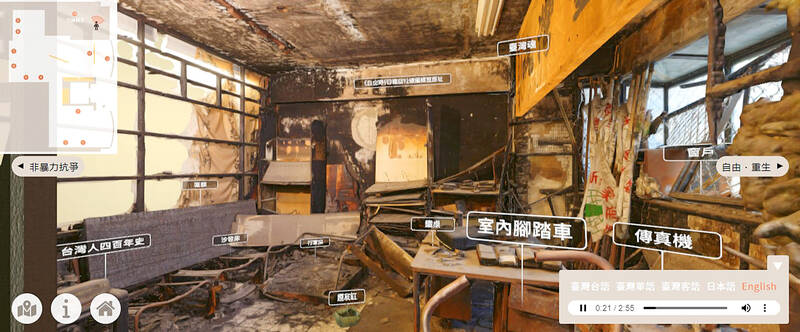There’s still no comparison between an online exhibition and visiting the actual space, but the gap is slowly narrowing — at least for information-based displays. Last Friday was Freedom of Speech Day (言論自由日) and to commemorate the occasion, the National Human Rights Museum (國家人權博物館) launched a 3D web museum dedicated to Deng Nan-jung (鄭南榕).
Deng, an outspoken proponent of freedom of expression, democracy and Taiwanese independence, self-immolated in his Freedom Era Weekly (自由時代) magazine office on April 7, 1989, just as the authorities and secret police were about arrest him for sedition. Although martial law had been lifted two years earlier, much of the government’s controls on society were still in place, and there was still a long way to go for Deng to achieve his goal of “100 percent freedom of speech.”
Regarding the museum, Deng’s widow and current presidential advisor Yeh Chu-lan (葉菊蘭) says she never thought that 34 years later, the destroyed magazine office that the authorities tried so hard to shut down would be seen by the world through the Internet.

Photo: Tsung Chang-chin, Taipei Times
“This piece of history needs to be told over and over to remind future generations how precious freedom is,” she said at a press conference on Thursday last week.
The online museum contains videos, pictures, art and artifacts detailing Deng’s life and ideals, reminding viewers of how grim things were just three decades ago and how far people would go to resist authoritarianism. The entire exhibition is in Chinese, but there’s an informative audio guided tour in Mandarin, Hoklo (commonly known as Taiwanese), Hakka, Japanese and English. I didn’t expect the detailed stories behind every displayed object to be translated into English, but organizers could have at least translated the titles into English.
As usual, navigating the space with a mouse and keyboard is the biggest obstacle. It’s better than many online exhibitions I’ve seen, but it’s still a bit clunky and hard to move around easily, especially since the space is quite cramped. The 3D modeling is detailed and well-done, however, and the exhibition route is intuitively designed. One problem is that it seems to be impossible to turn off the music.

Photo: Screenshots of vitrual museum
It’s much easier just to follow the guided tour, which takes about 50 minutes. Most striking are the charred remains of Deng’s office, where one can click on various surviving objects and learn about their significance. For example, he swapped his wooden table for a metal one at one point to prevent the fire from spreading, and also obtained a stationary bicycle so he could exercise during the 71 days he barricaded himself indoors to avoid arrest.
In addition to the main events in Deng’s life, the guide also provides historical context and connects the events to the present. Although today people can freely discuss their political positions and criticize the government, Taiwan is often censored on the international stage and its existence denied due to pressure from China.
“Some Taiwanese self-censor at home, others struggle to articulate who we are when we’re abroad,” the guide says.

Photo: Screenshots of vitrual museum
How to prevent and handle disinformation remains a major issue, and many problems remain regarding diversity, equality, justice and human rights. The exhibition leaves viewers with Deng’s last words: “What is left is up to you all.”
The physical museum is located at former magazine headquarters at 3F, 11, Ln 106, Alley 3, Minquan E Rd Sec 3, Taipei City (台北市民權東路三段106巷11號3F).
TAINAN EVENTS

Photo: Screenshots of vitrual museum
‧ Tainan City was the first to designate April 7 as Freedom of Speech Day in 2012, five years before it became a national observance. The city will be holding a series of events to commemorate the occasion.
‧ An art exhibition dedicated to Deng will run until Sunday at Punplace (胖地, 21 Nanmen Road, Tainan City, 台南市南門路21號) and surrounding stores, and there will also be displays at Tainan Cultural and Creative Park (臺南文化創意產業園區) until May 21.

Nine Taiwanese nervously stand on an observation platform at Tokyo’s Haneda International Airport. It’s 9:20am on March 27, 1968, and they are awaiting the arrival of Liu Wen-ching (柳文卿), who is about to be deported back to Taiwan where he faces possible execution for his independence activities. As he is removed from a minibus, a tenth activist, Dai Tian-chao (戴天昭), jumps out of his hiding place and attacks the immigration officials — the nine other activists in tow — while urging Liu to make a run for it. But he’s pinned to the ground. Amid the commotion, Liu tries to

The slashing of the government’s proposed budget by the two China-aligned parties in the legislature, the Chinese Nationalist Party (KMT) and Taiwan People’s Party (TPP), has apparently resulted in blowback from the US. On the recent junket to US President Donald Trump’s inauguration, KMT legislators reported that they were confronted by US officials and congressmen angered at the cuts to the defense budget. The United Daily News (UDN), the longtime KMT party paper, now KMT-aligned media, responded to US anger by blaming the foreign media. Its regular column, the Cold Eye Collection (冷眼集), attacked the international media last month in

A pig’s head sits atop a shelf, tufts of blonde hair sprouting from its taut scalp. Opposite, its chalky, wrinkled heart glows red in a bubbling vat of liquid, locks of thick dark hair and teeth scattered below. A giant screen shows the pig draped in a hospital gown. Is it dead? A surgeon inserts human teeth implants, then hair implants — beautifying the horrifyingly human-like animal. Chang Chen-shen (張辰申) calls Incarnation Project: Deviation Lovers “a satirical self-criticism, a critique on the fact that throughout our lives we’ve been instilled with ideas and things that don’t belong to us.” Chang

Feb. 10 to Feb. 16 More than three decades after penning the iconic High Green Mountains (高山青), a frail Teng Yu-ping (鄧禹平) finally visited the verdant peaks and blue streams of Alishan described in the lyrics. Often mistaken as an indigenous folk song, it was actually created in 1949 by Chinese filmmakers while shooting a scene for the movie Happenings in Alishan (阿里山風雲) in Taipei’s Beitou District (北投), recounts director Chang Ying (張英) in the 1999 book, Chang Ying’s Contributions to Taiwanese Cinema and Theater (打鑼三響包得行: 張英對台灣影劇的貢獻). The team was meant to return to China after filming, but